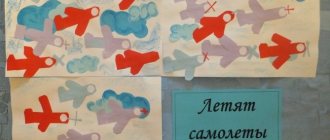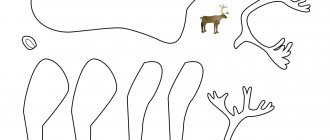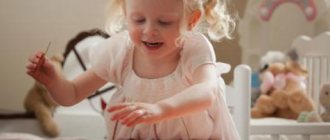Scheme for drawing up lesson notes
The lesson for children lasts 15 minutes. This time is distributed between three stages of mastering the topic:
- introductory stage - up to 3 minutes, aimed at motivating the children;
- the main stage - up to 10 minutes, devoted to a description of the work procedure, demonstration of drawing samples and the drawing process itself, which is preceded by finger exercises and/or physical education;
- the final stage - up to 2 minutes, during which the teacher praises and thanks all the kids for their work.
Table: Cheryapkina L. Summary of a drawing lesson on the topic “Balloons” in the second junior group (fragments)
| Stage | The essence |
| Introductory | The teacher tells the children that he has a gift for them and asks them to guess the riddle: I’m in a hurry for the holiday, I’m holding them by a thread: Red, yellow, blue - They float overhead, There’s nothing better for the kids than the airy ones. — Balloons (helps if children find it difficult to answer, shows a ball)…> |
| <… The teacher invites the children to play with the ball. Physical exercise: Children stand in a circle and hold hands. The adult slowly, melodiously pronounces the words, stepping back: “Inflate my balloon!” “Blow up big...” Everyone stops, holding hands and forming a large circle. The teacher continues: “Stay like that and don’t burst... bang!” - Let's inflate again! - Repeats the words of the game. The ball loves to be thrown up and caught, the ball wants to lie down, the ball can jump (children perform a variety of movements). | |
| Basic | Educator: - Do you like playing with the ball? Let's draw a lot of balls. — Kids love paints and pencils. We will use them to draw What? Can you guess? (ball) - Guys, today we will draw colored balls. You have multi-colored strings drawn on your leaves. Let’s “tie” a red ball to the red thread, a blue ball to the blue thread, a yellow ball to the yellow thread, and a green ball to the green thread. |
| Finger gymnastics | |
| The teacher shows the children how to hold the brush correctly: with three fingers, just above the iron tip, making sure that the children sit straight. First, children perform circular movements in the air, then carefully dip the brush first into water, then into paint. Excess paint is squeezed out on the edge of the jar. The brush is washed from paint and wiped with a napkin. | |
| Final | The teacher puts all the children's drawings on display, analyzes the children's work, praises the children, and, if necessary, helps a child who has difficulty completing a task. |
| Quote from: https://www.maam.ru/detskijsad/konspekt-zanjatija-po-risovaniyu-vo-vtoroi-mladshei-grupe-konspekt-nod-vozdushnye-shary-dlja-detei-2-ml-gr.html | |
Video: drawing lesson on the theme “Chicken” in the second junior group
Drawing on animalistic themes with younger preschoolers opens up new facets of their ideas about the world around them, expands the experience of perceiving the shapes, sizes of objects, as well as shades of colors. Practicing this type of art activity also helps to reveal the creative abilities of little pupils, teaches them to work with different materials for drawing, which is an important stage in the formation of experimental research activities. It also fosters a respectful and caring attitude towards animals and nature in general.
MAGAZINE Preschooler.RF
Notes on drawing for children of the 2nd junior group Topic: “Puppy”Target:
- Forming the ability of children to paint with a hard brush using the poking method, mastering the color palette (orange, brown).
Tasks:
Educational
- To develop children’s ability to paint with a hard brush using the poking method.
- Improve the ability to hold a brush correctly while working.
- Master the color palette (orange, brown)
- Strengthen the ability to draw with crumpled paper and select colors, complement small missing details using plasticine.
- Enrich children's vocabulary
Developmental
- Develop creative abilities and aesthetic perception.
Educational
- Cultivate a kind attitude towards pets.
- Cultivate activity and the desire to complete work to the end.
- Continue to encourage independence and creativity.
Correctional
- Develop fine motor skills of hands
Integration of educational areas:
- cognition
- communication
- artistic creativity
- socialization
- music
- health.
Materials:
Half a landscape sheet with a drawn outline of a puppy (for each child).
Brown, orange gouache, hard brush.
A small sheet of paper (palette) for each child to check the poke and the correctness of the chosen color, jars for brushes, plasticine lumps of different colors for the eyes (2 pcs.) and black for the nose (1 pc.), fabric napkins.
Two paper kennels (orange and brown) for the didactic game “Each dog has its own house .
Puppy caps for dynamic pause.
Demo material:
Outline of a puppy on a sheet of paper, film on a laptop with a picture of a puppy and a dog.
Preliminary work:
Looking at illustrations, postcards, paintings depicting dogs, playing with a toy dog, reading E. Charushin's stories about Tomka, watching the dog on a walk.
Progress of the lesson
Children enter the hall. Educator: - I’m very glad to see you, Hello! Draws children's attention to guests.
Children say greeting:
Hello hands - clap, clap! Hello legs - top, top! We need to say hello to each other! Hello dear guests!
We will draw!
The children turn to the teacher.
Voss: Guys, I’ll tell you a story about Grandma Arina (the teacher puts on an apron and scarf), who lived in a very beautiful, noisy yard and had many friendly, kind and funny pets.
The leader asks the children a question: “Do you like pets?”
Children: - Yes.
Then I invite you to take a walk through this wonderful yard and get to know my pets.
The voices of pets are heard. She lived with Ryaba the Hen, Rogatushka the Burenushka, a purring cat, a yoke horse and three cheerful little pigs.
Oh, guys, look, whose house is this? I wonder who lives in it?
Now I'll ring the bell. The sun calls (the monitor turns on), a dog and a puppy appear. A problematic situation is created: “How to help a puppy find friends ,” because he has no one to play with.
- Children, we need to help the puppy, draw friends. Shall we help? (Yes).
-I will teach you how to draw beautiful puppies using the poking method. Come to me. And the puppy will watch us how children can draw beautifully.
(Children approach the easel and stand in a semicircle.)
Educator: - You know how to paint with a soft brush, but today you will learn to paint with a hard brush. Try with your finger to see how hard the brush is... The brush bites...
Teacher (shows): - I put paint on a brush and paint with a poke: first I’ll paint the face along the contour, it’s round, and now in the middle. Then - the body, legs, tail. I’ll rinse the brush in water, dry it on a napkin and put it in a glass. And we will draw the grass under the paws in a way that is already familiar to you - with crumpled paper, what color? (green).
-Right. I put paint on a crumpled leaf and paint grass.
And I’ll make the nose and eyes out of plasticine, look. I take a small ball and press it to the muzzle with my finger, and now another one. Here are the eyes. And now the nose. Look how the dog turned out! Fluffy, soft, funny.
-Tell me, which brush will you use to paint the puppy’s fur? (hard).
-Where should you first draw the fur on the head or body?
Now sit down at the tables. Now we will do a little warm-up. Take a hard brush in your hands. Begin:
We hold the brush like this: (Hand on the elbow. Hold the brush above its metal part). It's difficult? No, it's nothing! The tassel poked and the heel clicked. (Move your hand along the text).
One poke, two pokes. And then, then, then (Circular movements of the hand). The brush runs around. Spun like a top.
After a poke comes a poke. (Children poke on the table with a dry brush).
- Well done, put some paint on a dry brush and get to work.
Independent work of children.
The teacher controls the drawing process and helps the children if necessary.
Physical education minute.
Friendly puppies run merrily, singing cheerfully in their ringing voices: “Woof - woof - woof!” And then the front legs raise,
And they happily wag their tails at each other. They ran away...... They played out (circling behind their tail). And everyone quickly gathered to see me (the teacher hugs the children) -2 times.
(Children perform movements in accordance with the text).
Voss: - Guys, we need to finish our work, and to do this, go to your tables. What haven't you done for the dogs yet?
Children answer: - Eyes and nose.
Voss: - That's right. Let's make eyes and a nose from plasticine. Take the small blue balls, these are the eyes, and place them on the puppy’s face and press with your finger.
-Well done! Ready!
-What else do we have left? Nose.
-Let's take a big black lump and make a nose for the dog.
Our puppies are ready.
-Now let’s draw the grass with crumpled paper.
Didactic game “Let’s put the puppy in the house .
Educator: - Children, take your work in your hands and come to me. In front of you are houses for puppies. We need to put brown puppies in a brown house, and orange (red) ones in an orange house. (Children place their puppies next to the houses of the corresponding color).
An analysis of children's work is carried out.
Educator: - Guys, what funny, wonderful puppies you have turned out to be: fluffy, cheerful! You tried, you worked carefully. Now Shustrik will have many, many friends!
A puppy is heard barking.
The boy turns on the laptop and a puppy appears, who is very happy and says to the children “thank you very much!”
Educator: - guys, let's remember what we did today? (Children's answers) What brush did you paint with? (hard). Well done! Today we tried, did a good deed for the puppy, and I’m giving you each a friend (the teacher gives out puppies).
Voss: - And now we need to return to the children's room. garden.
-Eyes close. The kids are smiling. The eyes open. They return to the kindergarten.
Summary of direct educational activities in artistic creativity Topic: “Puppy” 2nd junior group MBDOU No. 144 D/S “Sun” Educator high. sq. categories Kalacheva E.V.
| Next > |
On the topic: methodological developments, presentations and notes
Summary of an integrated lesson on visual arts (non-traditional drawing techniques) and music on the topic: “Cockerel”.
Summary of educational activities on visual activities (drawing) for children of the younger group “Rain, more often, drip-drip-drip!” using an unconventional technique of drawing with cotton swabs.
A bear comes to visit the children and the children introduce him to their city, Zavodoukovsk.
Animals are always very interesting for children. They love to draw them, but it is still difficult for small children to draw animals and the technique of painting with a dry brush “Poke” comes to their aid.
Program content: Teach children to draw in an unconventional way - with a cotton swab; Expand children's understanding of plants and animals in the spring; Develop children's skills in applying stains unconventionally.
Form friendly relations in the team, contribute to the accumulation of experience of friendly relations, a negative attitude towards rudeness. Develop children's spoken language and enrich their vocabulary.
Source
On the topic: methodological developments, presentations and notes
Goal: to form an idea of the family and its members, of the friendly, friendly relationships of relatives. Objectives: Educational: - naming family members, active use of generalizing words.
Goal: to teach how to depict round objects with one movement of the hand.
Summary of continuous educational activities in drawing in the second junior group “Boat”.
Summary of continuous educational activities in drawing in the second junior group, adapted for carrying out under quarantine conditions. “Apples for bunnies” Prepared by Kireychikova M.Yu.Ts.
Summary of continuous educational activities in drawing in the second junior group, adapted for carrying out under quarantine conditions. “Apples for bunnies.”
Development of productive visual activity: the ability to draw with cotton swabs, using gouache.
Source
Drawing in the second junior group of domestic and wild animals: lesson notes
| Author's full name | Title of the abstract |
| Zinchenko I. | "Fluffy kitten" (painting with a poke) Educational objectives: introduce the technique of poking using a dry brush, teach how to convey the distinctive features of a kitten. Developmental tasks: develop creativity, perseverance, accuracy when working with gouache paints. Educational tasks: to cultivate interest and respect for animals, the ability to notice the beauty of the surrounding world, the desire to help others. Integration of educational areas: “Artistic creativity”, “Cognition”, “Communication”, “Socialization”, “Health”. Demo material: toy cat. Handout: sheets of white paper with an outline image of a kitten according to the number of children, gouache (black, brown, gray and orange), sippy cups, brushes with stiff bristles, coasters for them. Progress of the lesson: A toy cat comes to the group of children. Children look at her, admire her white fluffy fur, and stroke her. The teacher invites the children to turn into little kittens themselves and conducts physical education with them:
The kittens “turn” into children again. The cat turns to them with a request: to draw shaggy fur for her kittens so that they do not feel cold in winter. The teacher informs the kids that they will paint with a hard brush and invites them to pick it up and touch it. The brush should be held vertically, closer to the “skirt”. Children are given the right to choose the color of their kitten - gray, red or black. The teacher demonstrates on the board the process of drawing fur on a finished silhouette of a kitten. Independent activity of children. Exhibition of works. The kitty is very happy (now the kittens won’t freeze in winter) and says “thank you” to the guys. |
| Ivanova E. | “And a zebra has stripes everywhere.” (painting with gouache) Doctor Aibolit comes to the guys and invites them to hot countries. Children guess riddles about African animals:
Then the guys close their eyes, sit on a magic carpet (an ordinary carpet) and “fly” to Africa. Pictures of animals are hung on the board. Physical education “Zebra striped” is being held
Doctor Aibolit points out that the zebra in the picture has no stripes - they were washed away by the magic rain. And only the guys can help the zebra - draw new black stripes for it. The teacher demonstrates techniques for depicting stripes. Independent activity of children. Exit from the fairy tale: preschoolers with Aibolit again sit on the magic carpet and fly into the group. Aibolit says goodbye to them. |
| Marchenko O.I. | "Let's dress up the hedgehog" (drawing with a felt-tip pen) A hedgehog from the forest comes to visit the kids. The teacher talks with the children, asks which of the children saw a live hedgehog and why it needs thorns. Physical education “Hedgehog and Drum” is being held
The teacher invites the children to “dress up the hedgehog” - draw needles on its back using a felt-tip pen. Demonstrates the imaging process. Children draw on their own and then look at each other's drawings. |
| Alekseeva F.Sh. | "Eared Hare" The teacher invites the kids to go skiing into the winter forest. Children imitate the process of putting on skis and go. In the snow (paper that lies on the floor) they notice someone's footprints. With the help of the teacher, the children determine that they belong to a fox, a bunny, a wolf and birds. Children guess the riddle about the hare. A sad bunny appears and whispers in the teacher’s ear that he is bored playing alone. The teacher and children offer to draw him many friends. They discuss what color this animal’s fur coat is in winter and what parts of its body it has. The teacher shows the children the process of drawing a hare with white paint using a hard brush. The image begins with the largest part - the body, then the head, ears, tail, and paws are drawn. Children realize that they are missing eyes, a nose and a mustache - they need to be painted with a regular brush. Physical education “Hares” is being held
Children draw on their own. The bunny is very happy that he has found new friends and says goodbye to the kids. The way out of the fairy-tale situation is for the children to “put on” their skis again and return from the forest to the group. |






